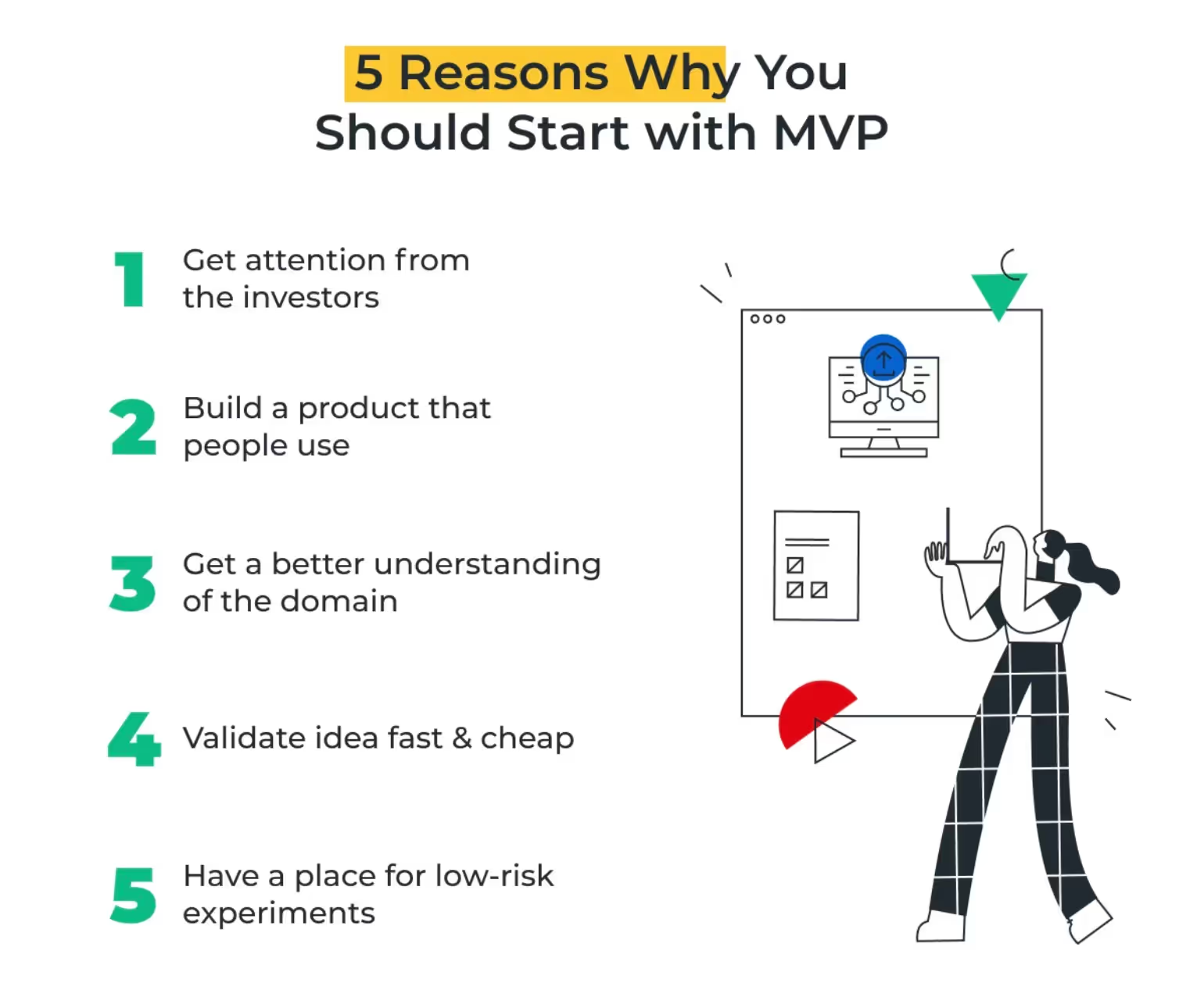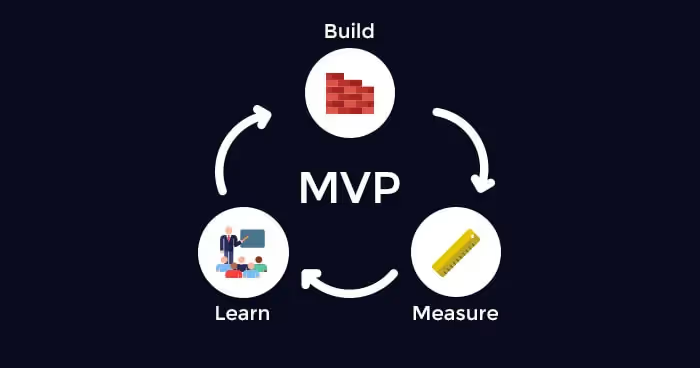The fast-paced world of startups has a lot of acronyms that may seem confusing to the unprepared. MVP, or Minimum Viable Product, is also a term that carries significant weight. It offers a powerful approach to product development and market testing.
At Arounda, we understand that MVP in a startup is not a raw product with half of the features chopped out; instead, it presents a strategic approach to product management. It encourages learning, evolution, and growth within the business. This article will explore the startup MVP's relevance and showcase some inspiring MVPs in business examples.
Defining an MVP in a Startup
Startup MVP meaning comes from the Lean Startup methodology introduced by Eric Ries. An MVP is the most basic product version. It has just enough features to satisfy early users while providing feedback for future development.
An MVP in a startup is not a stripped-down version of the final product. It's a strategic tool to learn about customers, confirm (or refute) product assumptions, and shape your business strategy.
Why Is an MVP Necessary?

A well-crafted MVP serves as a reality check for startups. It enables them to test their business ideas in the real world, using real customers. This approach shows the collection of crucial insights that market research and predictive analytics alone might not reveal.
An MVP in a startup helps conserve resources. Instead of committing significant time, money, and effort to a fully realized product that may or may not succeed, startups can develop and launch an MVP to gauge market response. Based on the feedback, they can iterate and improve the product.
The MVP in lean startup methodology also assists in attracting investors. A successful MVP launch provides proof of concept and market demand. It makes securing further funding for development easier.
The Types of MVPs for Startups
Choosing the correct type of MVP in a startup depends on your business goals, target audience, and the kind of feedback you want to gather. Some of the most commonly used types:
Explainer Video
An explainer video is a simple, straightforward way to present your product idea to your audience. You can gauge interest and secure early signups by making a compelling video. It illustrates how your product works and solves users' problems.
Wizard of Oz MVP
The startup simulates the product's functionality behind the scenes while presenting users with a simplified front-end interface. The startup manually performs the back-end tasks, giving the illusion of a fully automated product. This MVP allows for testing user interactions and validating assumptions.
Concierge MVP
It involves manually delivering the product's core functionality to users instead of building a full-scale automated solution. Concierge MVP allows startups to test the demand and assess user behavior. For example, a food delivery service might start by manually taking orders via phone calls rather than building a complex app.
This is similar to the Wizard of Oz MVP, but in this case, the client knows that the service is manually managed.
Landing Page MVP
A landing page MVP comprises a simple webpage describing the product's value proposition. It also collects user information, such as email addresses or signups. This approach helps gauge user interest and willingness to engage with the product or service.
Prototype MVP
It involves creating a basic product version showcasing its core features and functionality. The prototype may be partially functional but visually represents the product's concept, design, and UX.
Pre-order/Presale MVP
Startups can measure market demand and validate their product concept by offering pre-orders or presales of the product. It generates early revenue and provides insights into the pricing strategy.
Single-feature MVP
It focuses on delivering a single key feature or functionality that addresses a specific user need. By concentrating on the core value proposition, startups can quickly build and test the most critical aspect of their product while gathering feedback and validating assumptions.
MVP Benefits for Your Startup

With an MVP, your startup will get:
Accelerated Learning and Validation
MVP lets you observe how your target audience interacts with a product, what they like or dislike, and what features they find most useful. The MVP in business meaning also includes the idea that the product will undergo iterations based on customer feedback to meet market needs better.
Market Validation
Instead of relying on assumptions or market research alone, an MVP allows startups to test their product in action. If the MVP resonates with users, startups can be confident in its potential success and plan for scaling up. Conversely, startups can reevaluate their strategy if the MVP does not achieve the desired traction.
Investor Attraction
Investors often look for proof of concept before investing in a startup. An MVP in a startup, with its initial set of users and feedback, can serve as that proof. The ability of your product to attract and retain users demonstrates business viability.
Reducing Risk
The risk of failure is inherent in every startup venture. Developing an MVP mitigates this risk. By launching a product and receiving customer feedback, startups can address issues early on. This process allows for continuous improvement, increasing the chances of long-term success.
Challenges in Creating an MVP in a Startup
Here are some common issues startups face while developing an MVP:
- Identifying the essential features that provide value can be challenging. Startups must balance and include enough features to attract users. But not so many that the development process becomes too complex and time-consuming.
- Misunderstanding the market need is a common issue. Startups must have a deep understanding of pain points and need to ensure the MVP offers a solution that users find valuable.
- Collecting user feedback after launching an MVP is crucial for improving and pivoting if necessary. Gathering this feedback and then understanding how to apply it to the product can be complex.
- It can be difficult to tell early users that the MVP in lean startup is a preliminary product version. It leads to potential disappointment or confusion. Managing expectations while attracting and retaining users can be a delicate cause.
Understanding these challenges can help startups create a successful MVP.
MVP in Business Example: Success Stories
Let's look at some startup MVP examples that illustrate its use.
Dropbox
Dropbox's founders made a simple video demonstrating how the product would work. The video attracted considerable attention and user signups, validating the need for such a service long before the product was fully developed.
Uber
UberCab was a basic app that connected iPhone users with drivers. This MVP allowed Uber to test the market's response to such a service before evolving into the global one we know today.
Airbnb
Airbnb started as a website offering short-term living quarters and breakfasts for those unable to book a hotel during the industrial design conference in San Francisco. The positive response showed the founders the potential demand for this service.
Final thoughts
The MVP in business is a lean, iterative approach that puts the customer at the heart of product development. Implementing an MVP in a startup provides tangible proof of concept, offers insights into the market, and can even attract further investment. While it may seem daunting initially, adopting the MVP methodology can significantly increase a startup's chances of long-term success.
Our company has more than five years of experience, during which we have helped many startups realize their potential. We have provided innovative solutions and strategic insights that have been instrumental in launching successful products. Many of them started as MVPs.
Whether you are just starting with an MVP or are looking to scale your existing product, our seasoned team is ready to help you navigate the path ahead.












